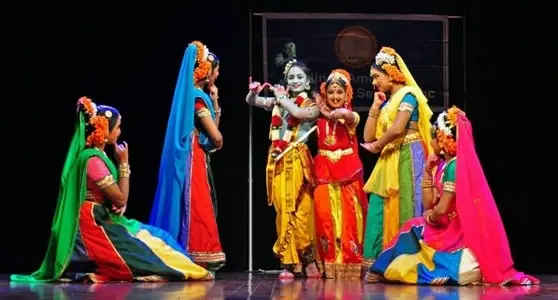The folk dances of Uttar Pradesh showcase the state’s diverse and colorful cultural heritage. These dances, such as Raslila and Ramlila, are deeply rooted in mythological tales featuring revered figures like Lord Rama and Lord Krishna. Raslila, for instance, beautifully portrays the love story of Krishna and Radha through graceful movements and expressions. Ramlila depicts episodes from the life of Lord Rama, focusing on his virtues and heroic deeds.
Khyal, Nautanki, Naqaal, Swang, Dadra, and the Charkula Dance are other significant folk dances that add to the rich tapestry of Uttar Pradesh’s cultural tradition. These dances often involve lively music, colorful costumes, and energetic performances, captivating audiences with their storytelling and artistic expressions. Each dance form carries its unique essence, reflecting the heritage, beliefs, and values cherished by the people of Uttar Pradesh for generations.
List of Folk Dance Styles Of Uttar Pradesh
1. Raslila Dance

The Raslila performed in Uttar Pradesh, specifically Braj Raslila, holds deep cultural significance as it traces its origins to the Braj region. This particular form of Raslila is an enactment of Lord Krishna’s captivating life, highlighting his endearing moments from childhood to youth and showcasing his divine love with Radha, his beloved consort. The dance is a theatrical presentation that brilliantly captures the essence of Lord Krishna’s playful and affectionate relationships with the Gopis (cowherd girls) as well.
2. Ramlila Dance
Ramlila stands as a cherished traditional folk dance in Uttar Pradesh. It revolves around the epic saga of Lord Rama, a revered incarnation of Lord Vishnu, as depicted in the Ramayana. Ramlila vividly portrays various significant events from Rama’s life, such as his exile from the kingdom of Ayodhya, the eventual victory over the demon king Ravana, and the heartfelt interactions between Rama and Sita.
3. Khyal Dance
Khyal, a prominent folk dance from Uttar Pradesh, has gained popularity across multiple Indian states. Initially rooted in Uttar Pradesh, Khyal boasts various styles named after cities, acting methods, communities, or authors. Styles like Jaipuri Khyal, Abhinaya Khyal, Gadhaspa Khyal, and Ali Baksh Khyal showcase distinct nuances, highlighting their unique characteristics.
Typically mythological, Khyal performances draw inspiration from events in the Puranas. Creatively presented, these dances delve into the historical aspects of these events while infusing elements of romance, valor, sentiments, and beliefs. These renditions skillfully intertwine mythological narratives with artistic interpretations, captivating audiences with their creative expressions and vivid storytelling.
4. Naqaal Dance
Naqaal plays often feature a storyteller character, and the themes predominantly revolve around the common man’s life, placing them at the heart of the performance.
Naqaals typically involve skilled performances by individuals from the Mirasi, Naqaal, and Bhand communities. These artists exhibit specialized skills while presenting this art form, infusing it with depth and engaging storytelling that resonates with audiences through its portrayal of common life experiences and societal nuances.
5. Nautanki Dance
Nautanki encompasses folklore and mythological dramas intertwined with folk songs and dances. Often, Nautanki artists come from families with generations dedicated to this profession. While many are illiterate, some professional singers have also joined Nautanki groups.
The music in Nautanki combines elements of classical and folk songs, accompanied by poems written in various metrical patterns. During performances, the instrument used is the Nagada, a single-faced kettledrum. Its sound often heralds the beginning of a Nautanki performance in village areas, setting the stage for this vibrant and captivating art form.
6. Charkula Dance
The Charkula dance is a traditional folk dance widely practiced in Uttar Pradesh, particularly in the Braj region. During this performance, veiled women gracefully dance while balancing a large multi-tiered circular wooden pyramid atop their heads. The wooden pyramid is adorned with 108 oil lamps, illuminating the dance.
Typically, the women perform the melodious ‘rasiya’ songs dedicated to Lord Krishna. This captivating dance form holds special significance as it is traditionally performed on the third day after the Holi festival, believed to be the day of Radha’s birth. According to mythology, Radha’s grandmother joyously ran out of her house while balancing the charkula on her head to announce Radha’s birth. Hence, the Charkula dance symbolizes the exuberance and happiness of a grandmother celebrating this auspicious occasion.
Santosh Kumar is a Professional SEO and Blogger, With the help of this blog he is trying to share top 10 lists, facts, entertainment news from India and all around the world.
